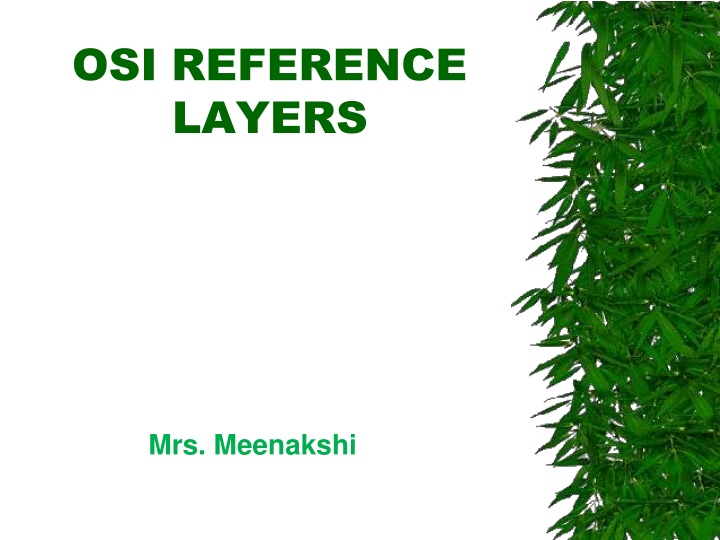
OSI Reference Layers in Computer Networking
Explore the OSI (Open Systems Interconnection) model which consists of seven layers: Physical, Data Link, Network, Transport, Session, Presentation, and Application. Learn about the functions and responsibilities of each layer in facilitating communication between different systems.
Download Presentation

Please find below an Image/Link to download the presentation.
The content on the website is provided AS IS for your information and personal use only. It may not be sold, licensed, or shared on other websites without obtaining consent from the author. If you encounter any issues during the download, it is possible that the publisher has removed the file from their server.
You are allowed to download the files provided on this website for personal or commercial use, subject to the condition that they are used lawfully. All files are the property of their respective owners.
The content on the website is provided AS IS for your information and personal use only. It may not be sold, licensed, or shared on other websites without obtaining consent from the author.
E N D
Presentation Transcript
OSI REFERENCE LAYERS Mrs. Meenakshi
CONTENTS INTRODUCTION WHAT IS OSI? OSI MODEL TYPES OF LAYERS PHYSICAL LAYER DATA LINK LAYER NETWORK LAYER TRANSPORT LAYER SESSION LAYER PRESENTATION LAYER APPLICATION LAYER CONCLUSION
What is OSI? OSI-OPEN SYSTEMS INTERCONNECTION An open system is a set of protocol that allows any two different systems to communicate regardless of their underlying architectures. It was designed by ISO-International Organization for Standardization in late1970s. It is a seven-layer model. It is a theoretical model designed to show how a protocol stack should be implemented.
OSI MODEL 7 Application layer 6 Presentation layer Session layer 5 Transport layer 4 Network layer 3 Data link layer 2 Physical layer 1
TYPES OF LAYERS Physical layer Data link layer Network layer Transport layer Session layer Presentation layer Application layer
PHYSICAL LAYER The physical layer is responsible for transmitting individual bits from one node to the next Functions of physical layer: Physical characteristics of interfaces a n d media Representation of bits Data rate Synchronization of bits
PHYSICAL LAYER From data link layer To data linklayer 101010000000101111001 101010000000101111001 Physical layer Physical layer Transmission medium
DATA LINK LAYER The data link layer is responsible for transmitting frames from one node to the next FUNCTIONS OF DATA LINK LAYER: Framing Physical addressing Flow control Error control Access control
DATA LINK LAYER From network layer Tonetwork layer frame frame H2 T2 Data H2 T2 Data Datalink layer Datalink layer Tophysical layer From physical layer
NETWORK LAYER The network layer is responsible for the delivery of packets from the original source to the final destination FUNCTIONS OF NETWORK LAYER: Logical addressing Routing
NETWORK LAYER From transport layer To transport layer packet packet H3 Data Data H3 Network layer Network layer To data link layer From data link layer
TRANSPORT LAYER The transport layer is responsible for delivery of a message from one process to another(process-to-process delivery) FUNCTIONS OF TRANSPORT LAYER: Port addressing Segmentation and reassembly Connection control Flow control Error control
TRANSPORT LAYER From session layer To session layer segments segments Data H4 Data H4 Data H4 Data H4 Data H4 Data H4 Transport layer Transport layer From network layer To network layer
SESSION LAYER The session layer is the network dialog controller. It establishes, maintains,and synchronizes the interaction between communicating systems FUNCTIONS OF SESSION LAYER: Dialog control synchronization
SESSION LAYER From presentationlayer To presentation layer L6 data L6 data Session layer Session layer H5 H5 syn syn syn syn syn syn L5 data L5 data To transport layer From transport layer
PRESENTATION LAYER The presentation layer is concerned with the syntax and semantics of the information exchanged between two systems FUNCTONS OF PRESENTATION LAYER: Translation Encryption Compression
PRESENTATION LAYER From applicationlayer To applicationlayer L7 data L7 data Presentation layer Encoded,encrypted & compressed data Presentation layer Decoded ,decrypted & decompressed data H6 H6 L6 data L6 data From session layer To session layer
APPLICATION LAYER The application layer enables the user,whether human or software, to access the network. It provides user interfaces and support for services. FUNCTIONS OF APPLICATION LAYER: Network virtual terminal File transfer,access,and management(FTAM) Mail services Directory services
APPLICATION LAYER User User Application layer Application layer X.500 FTAM X.400 X.500 FTAM X.400 L7 data L7 data From presentationlayer To presentation layer
